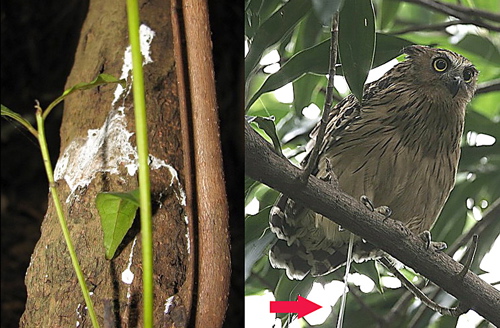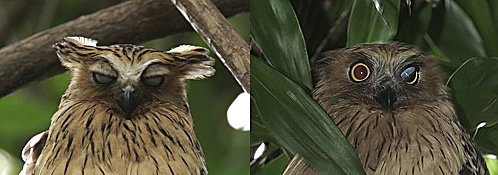The owl was faithfully perching on the same branch of the same tree almost every day for most of February 2007. It was there from early morning to late evening and was clearly visible to passersby. Where else can you view an own during the day but at Sentosa?
Yes, this is Sentosa’s very own Buffy Fish Owl (Ketupa ketupu).
The owl advertises its presence by the whitewash that stains the vegetation below. This is actually the bird’s liquid faeces and urine, made up mainly of uric acid (above).
The owl is normally seen with one foot on the branch and the other hidden among the body feathers. Its eyes are either opened, half-open or closed. When excessively stressed, especially by the presence of noisy trekkers below, it opens its eyes wide, the ears become erect together with all the feathers around (below). Note the nictitating membrane in both the eyes in the image on the right.
Although most people believe that owls can see in the dark and are blinded by bright light, this is not so. In total darkness as during moonless nights, they are not able to see. But the presence of starlight is enough for them to see. They can still see during the day. But as with night vision, owls can only see in varying degrees of black and white.
The eyes can react to the amount of light available by varying the size of the pupil through the action of the iris. As with many nocturnal animals, the eyes of owls, when exposed to a source of external light at night, respond with varying degrees of “eyeshine” – appearing to glow from red to gold (below right).
The two large and round eyes are placed directly in front, unlike in most other birds where the eyes are on the sides. This provides excellent binocular vision and with it depth of field, an advantage in gauging distances and in ensuring successful hunts.
The large eyes are not spherical but rather like elongated tubes embedded in the head. And because of this there can be no eyeball movement.
The owl is thus provided with an extremely flexible neck that allows the head to turn up to 270 degrees in either direction. This allows the bird to see behind without turning its body (left). It is also able to turn its heads almost completely upside down, allowing it to see upwards with binocular vision.
During rest, the upper and lower eyelids close. But in blinking, only the upper eyelid is involved (above left). The third eyelid, a translucent nictitating membrane that moves sideways, assists in protecting the eye and to keeping it clean (above right, left eye).
A closer look at the eyes show the presence of “eyelashes” that are actually special feathers that function to keep insects off the eyes (below).
There must be plenty of food around, especially rodents, for Sentosa to have such a visible owl mascot – as well as other species of owls. We are confident that the resort staff will not eliminate these rodents by baiting them with rat poison. Owls will eat the poisoned rats and be in turn poisoned. This is one way of moving towards a sanitised and faunal-free resort island.
Update: According to today’s Sunday Times, Sentosa Development Corporation is organising a walkabout and closed-door discussion with green groups, etc. on the clearing of the forest to make way for the Integrated Resort. As such, the area has been spruced and vegetation stained by the owl’s whitewash (top left) has now been cleaned. In the process the owl must have been disturbed and is nowhere to be seen for the past week.
Input by Melinda Chan and YC, images by Chan Yoke Meng.














2 Responses